In a darkish, rundown breakfast bar in Galicia, some 450 miles west of Pamplona, I sat nervously, consuming my pan con tomate as a TV overhead introduced the 2024 Operating of the Bulls. On my plate, the smashed tomato toast dawn stippled with garlic slivers was so savory and satisfying that I virtually forgot the rationale I had traveled to Spain within the first place.
This isn’t a narrative about bulls and scarlet sashes. Not like Hemmingway, I used to be trying to find which means in a quieter, less-trodden nook of Spain: the rugged Costa da Morte within the nation’s northwest. O Camiño dos Faros. The Approach of the Lighthouses.
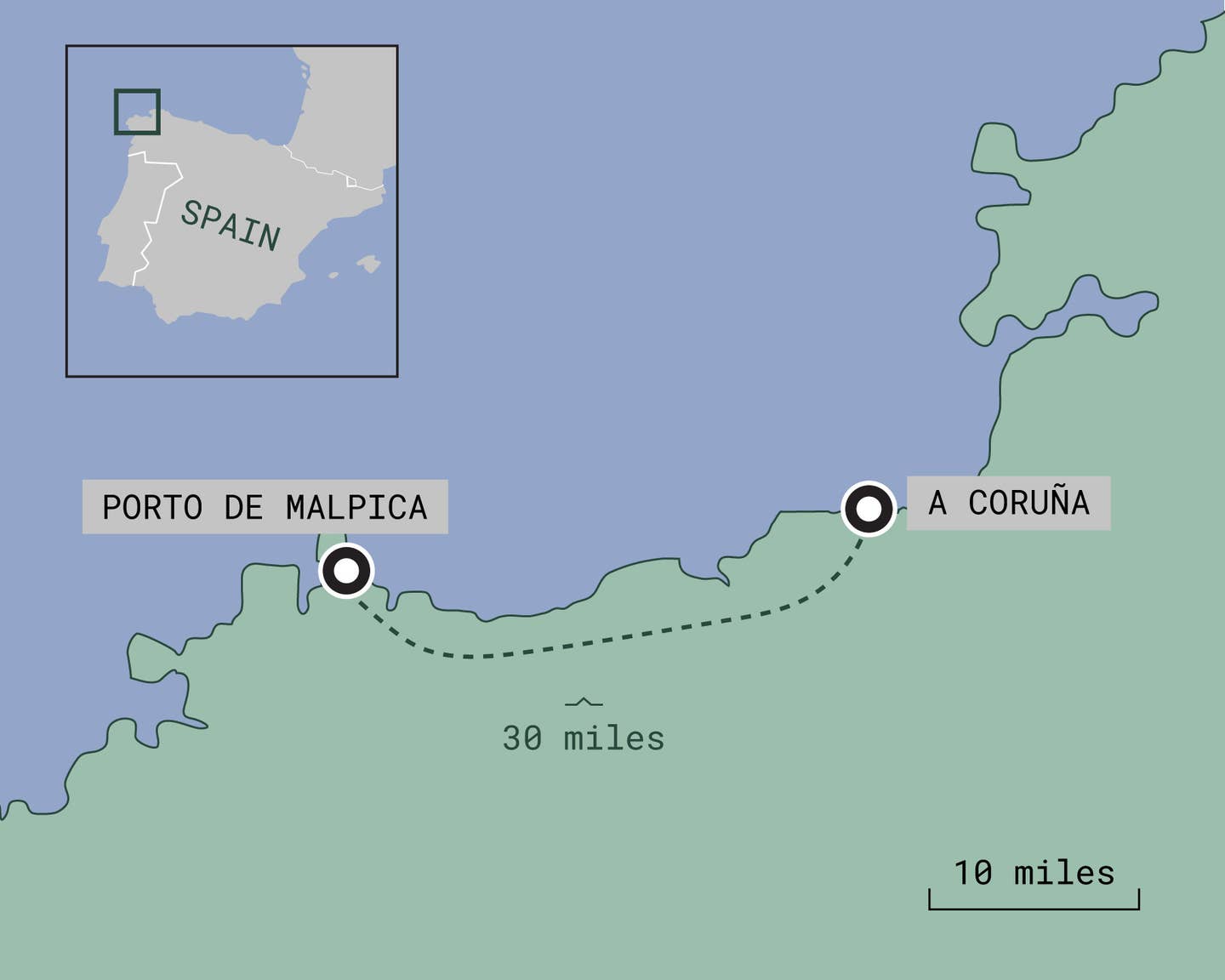
Throughout the desk, Tamlyn, a UK-based wine author from Zimbabwe, and her husband, Brad, a grasp’s scholar from South Africa, sipped their second cafés sin leche. After the pandemic, the three of us had made a pact to pursue unfinished chapters and unresolved endings. Our first problem was this 125-mile gauntlet, which we hoped would floor us by way of folks and place—with good consuming and ingesting alongside the way in which.
That a lot I knew about Galicia, Spain’s misty inexperienced oasis propped atop Portugal: It was a culinary wonderland, a technicolor fever dream of untamed seafood, earthy greens, and creamy cheeses—all completed with a contact of olive oil, a sprinkle of smoked paprika, or a pinch of salt that harked again to the encircling sea.
On the stroll, we’d hopefully style all of it. However earlier than placing out, we appeared over the route one final time. First was a fast drive to the trailhead within the distant fishing village of Porto de Malpica, from which we’d comply with a serpentine path alongside the wild western shoreline, traversing dizzying granite cliffs, sandy turquoise seashores, and ethereal eucalyptus stands to the ultimate vacation spot the Romans named ‘Finis Terrae’—land’s finish. So started our path of sunshine, following the coast of loss of life to the top of the world.
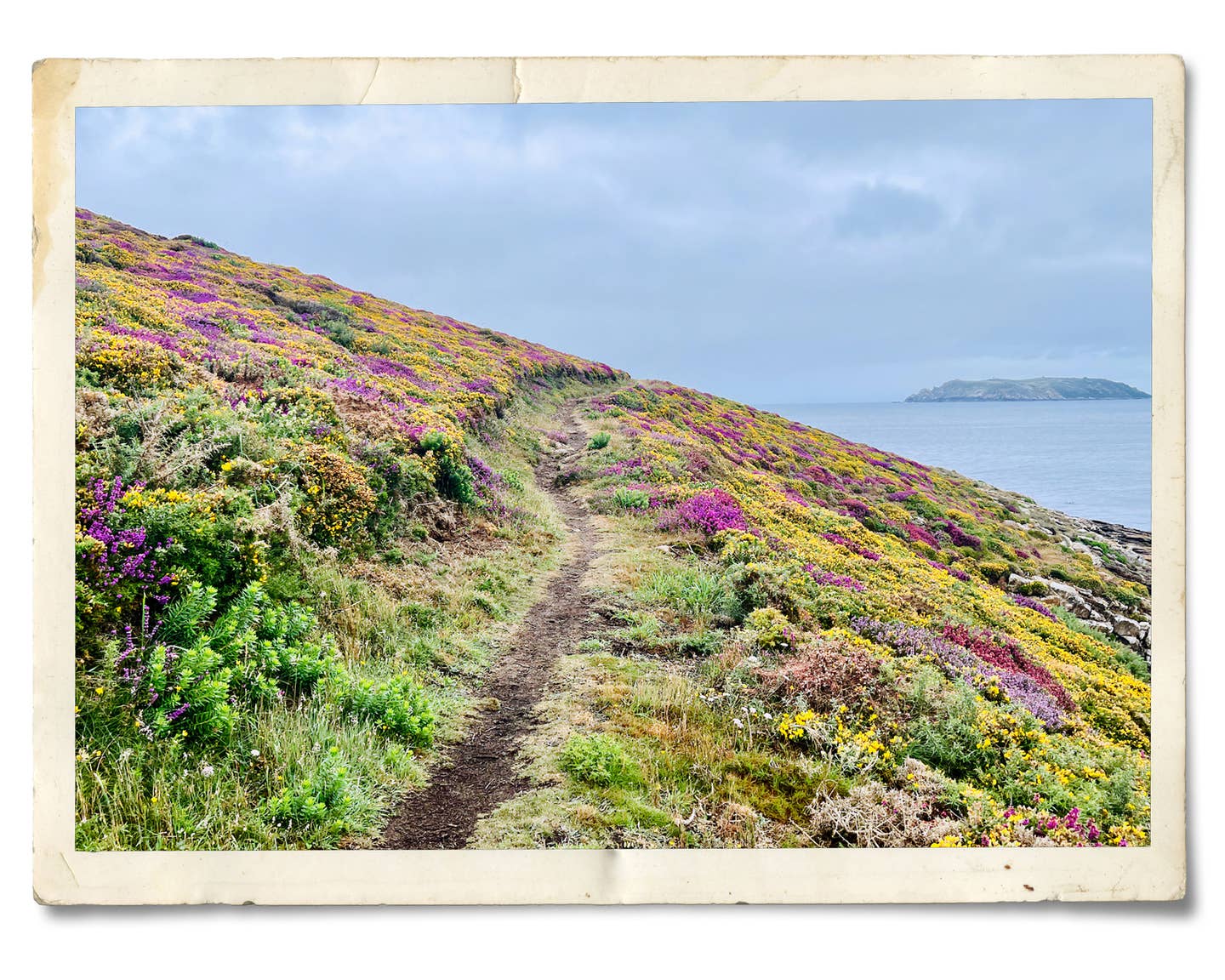
Day 1: I Spy with My Little Eye…
Our driver, Jorge, turned out to be a hardcore “trasno,” native slang for an individual who has efficiently accomplished the Camiño. (A “traski,” then again, was someone at the moment on the hike.) “I’ve walked it over 60 instances,” he mentioned by way of a translation gadget hooked into the taxi’s sound system.
The windshield wipers struggled to maintain tempo with the rain, at the same time as he assured us the storm would move in time for our lunch cease at Restaurante O Xan close to Praia de Barizo. We requested him how he knew, and he shrugged: “Galicia.”
The deep, tangled roots of the native Galego language embody Germanic and Celtic origins in addition to Portuguese, Spanish, and Latin. But, for many of these eight days, it felt as if Galicia itself wanted translating. To me, the area was an entirely unfamiliar Spain, worlds away from the sun-soaked sands of Costa del Sol, the colourful nightlife of Madrid, and the bustling crowds of Barcelona. Even the panorama would show to be as changeable because the climate, shape-shifting from dramatic seascapes to bucolic knolls to fairytale forests the place iridescent moss and outsized bracken appeared to reclaim all they touched.
Jorge’s recommendation as he snapped our image on the Camiño’s begin? Maintain the ocean to your proper.
We set off, armed with laminated maps, small luggage of nuts and do-it-yourself biltong, and a bottle of native mencía wine. Our trekking sticks discovered their rhythm in opposition to the moist cobblestones as we handed a small seaside bar. I puzzled if the boys sitting outdoors have been taking bets on our probabilities.
We began our ascent into heath-covered bluffs, passing miles of untamed hydrangeas in hues from pale pink to cerulean blue. Within the distance, we spied the define of the uninhabited Sisargas Islands and the automated lighthouse, the primary heading south on the damaging Costa da Morte. Once we grew hungry, we foraged for peppery orange nasturtiums, spicy fennel stalks, and the candy nectar of honeysuckle blossoms. The nearer we walked to the ocean, the extra the creeping lime-colored stands of rock samphire obscured the black stone partitions by which they grew. The briny, natural taste of their fleshy stems tasted like an extension of the ocean under.
Eight miles in, I used to be grateful for the nourishment after we found our lunch cease was little greater than a uncared for façade consumed by brambles. We took cowl from the persevering with rain underneath the crumbling patio roof and divided the biltong and wine amongst us.
Following lunch, the distant path pale right into a hint. This promise of solitude was one of many Camiño’s calling playing cards, and all of the sudden, our solely companions have been the ocean daffodils, scrambling gromwell, and pink dorset heath swathed within the crimson filigree of a plant referred to as fairy hair. At instances, our path resembled a pulled thread on the tapestry of the Galician coast fluttering within the afternoon winds.
Finally, we glimpsed the path’s second lighthouse at Punta Nariga amid a panorama of seemingly sculptured stone. Whipping winds changed the rain as we rounded the rocky level. Constructed by architect César Portela in 1995, Spain’s latest lighthouse resembles the bow of a ship rising 164 toes above a rugged outcrop. From right here to the day’s end, we misplaced all cell protection and needed to depend on the lighthouse and the ocean to steer us ‘residence.’
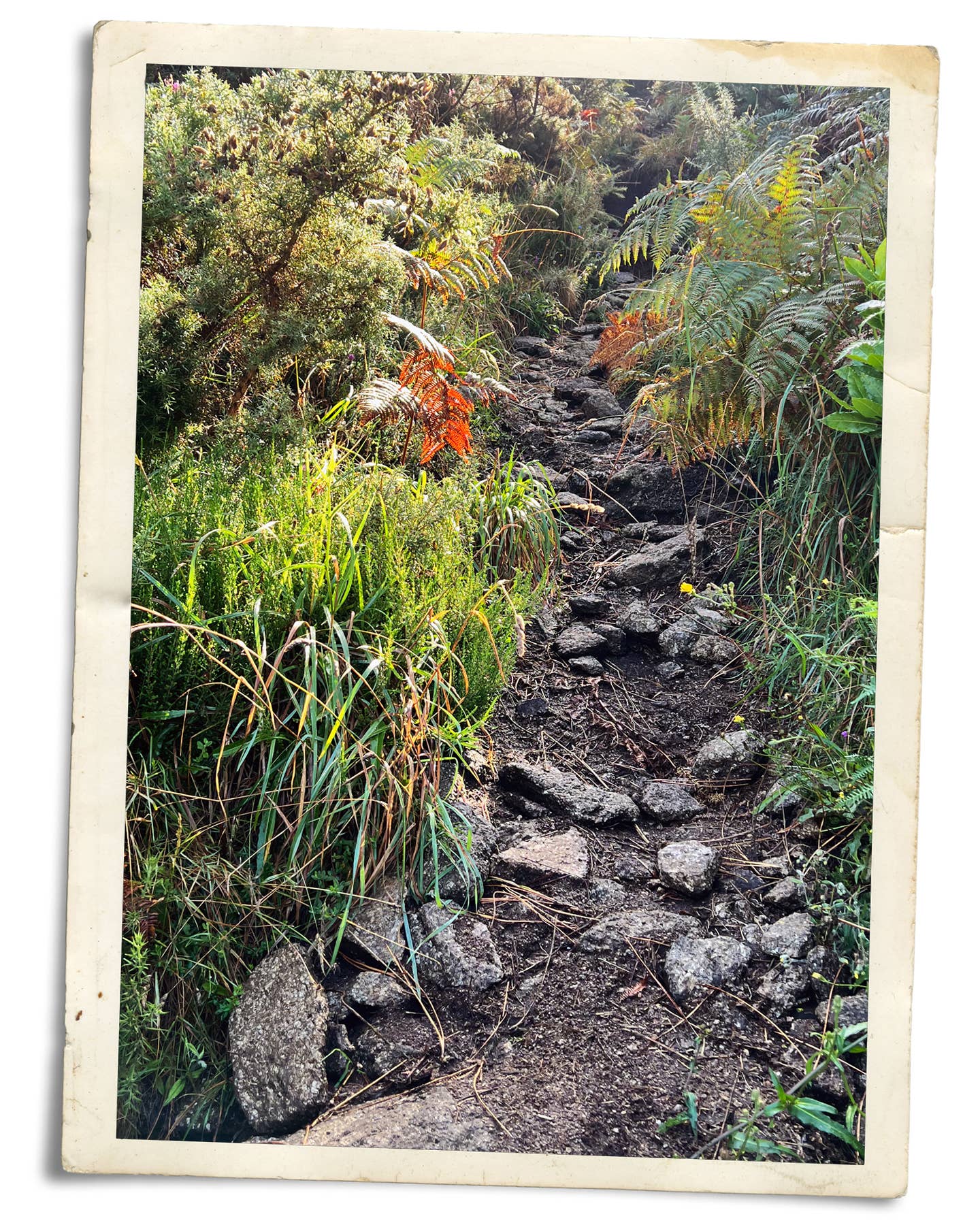
We have been ravenous by the point we hobbled into Resort Teyma for a dinner that started with cazuelas of chickpea and chorizo stew and continued with squid ink croquettes and grilled razor clams. Freshly plucked and easily ready seafood mirrored the purest bounty of the Atlantic.
With a bottle of albariño and the occasional godello—refreshing native varieties as sincere because the regional meals they complement—a variation on these staples would change into our nightly constants. Menus have been uncommon, however suggestions—as finest we may decipher them—have been plentiful.
Day 2: Thar’ Be Percebes Forward
The 17-mile trek from Niñóns to Ponteceso demanded one of many largest altitude positive aspects of the journey. I woke as much as a tub—my impromptu washer—ringed with Galician mud. After inspecting my toes, I taped up a sizzling spot effectively on its strategy to changing into a blister. My thighs shook on the steps all the way down to breakfast, but it surely didn’t matter; I’d been trying ahead to this morning for months. At the moment was percebes day.
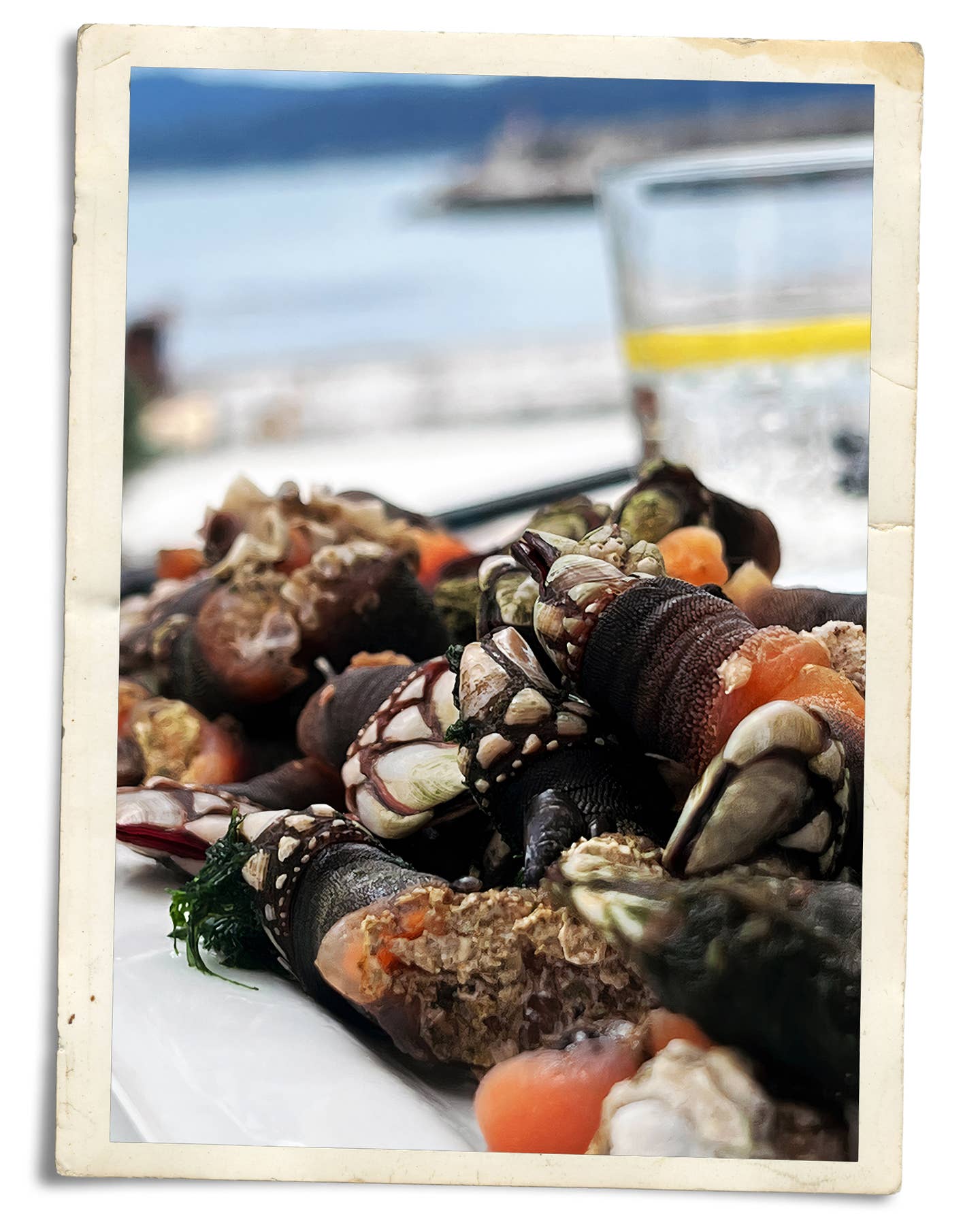
Rising up in New England, I’d reveled in a Maine lobster bake, every course steamed in seaweed we collected ourselves. I’ve burrowed in mud at low tide and brought seawater in my eye in pursuit of littleneck clams. However percebes have been uncharted territory. Referred to as Lucifer’s fingers or gooseneck barnacles in English, these prehistoric-looking critters use their thick, rubbery necks to connect to intertidal rocks, the place they reside within the highly effective surf. The rougher the ocean, the shorter (and meatier) the crustacean’s neck—and the upper the value. The harvest, which requires working the rocks by hand, is as harmful as it’s tough. Percebeiros, who should adhere to strictly regulated yields, threat life and limb for the prized Galician delicacy.
As soon as harvested, although, cooking them is a cinch: A 3-minute dunk in sizzling water seasoned with a bay leaf, then an equally temporary ice plunge ensures the right temperature and consistency. Cool sufficient to the touch, heat sufficient to style, with a draw of lemon on the facet.
However as a lot as we wished to linger at breakfast, it was time to chug on. Extra percebes have been ready. Past Faro do Rocundo, we stopped for lunch at Cervecería Bernaldo within the wild, white-capped Port of Corme. We pointed to the “hay percebes” chalkboard out entrance and ordered.
“You are taking the lead,” Tam advised when the plate of tiny dinosaur toes arrived. My preliminary makes an attempt resulted in spilled juice and profanity earlier than lastly determining the best way to take away the powerful outer pores and skin. The tender meat inside was surprisingly tender and candy, akin to a Maine softshell lobster or a gently baked oyster. Midway by way of our plate, the one hikers who had handed us the day earlier than sat down at a close-by desk. Communication once more flowed by way of Google Translate, pantomime, and good will. Then, considered one of them noticed Brad working his percebes with a fork. She approached our desk and wagged a finger on the fork, “Sin tenedor!” Pinch, pull, et voilà—or the Galician equal thereof. Sea to your proper. Percebes together with your palms… Our crash course continued.
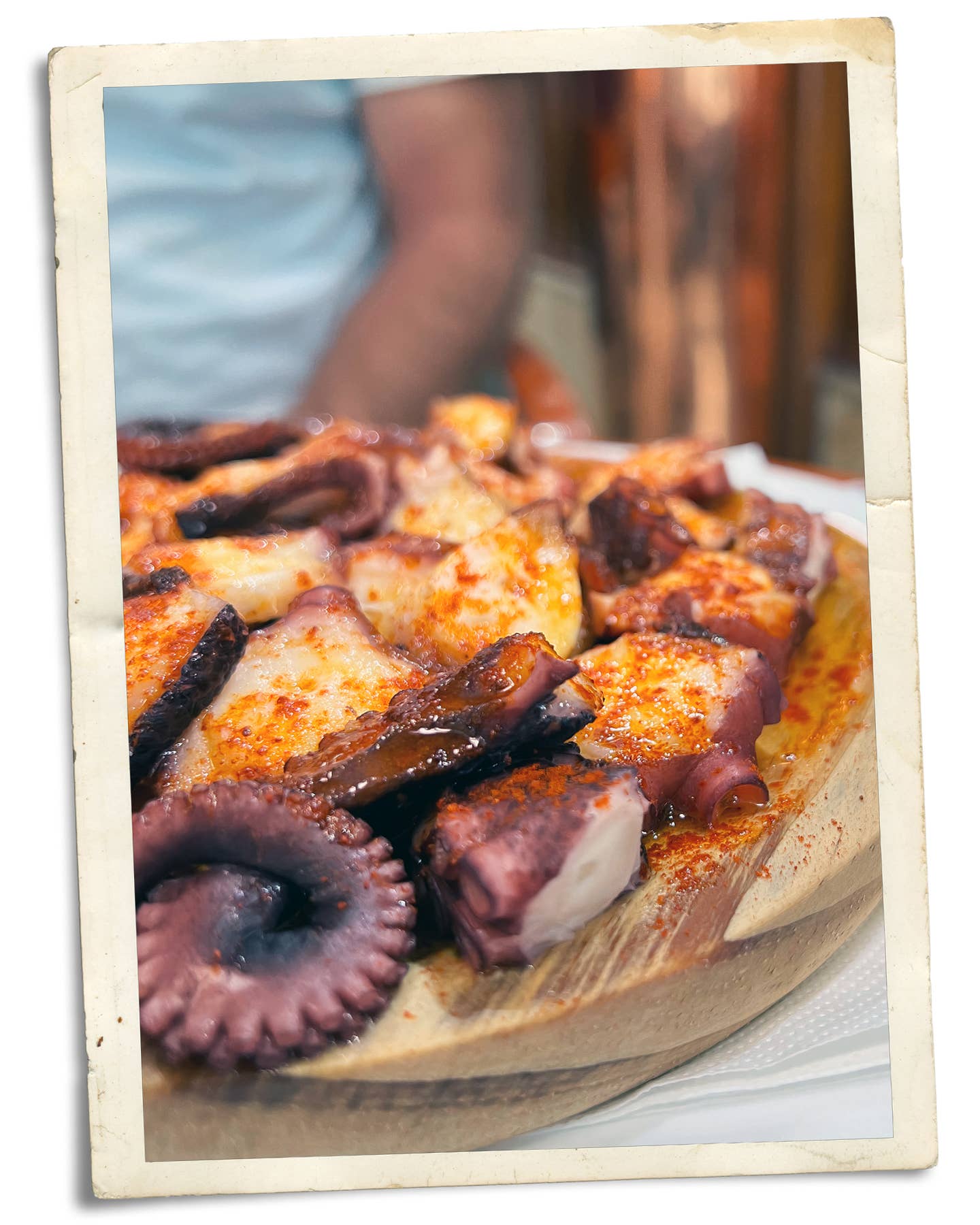
That evening, having logged over fifteen miles, we tried our luck with one other Galician biggest hit: polbo á feira. A wood board of opal-hued octopus arrived, dressed with a crimson glitter of paprika and salt. Reduce into small discs, the boiled bounty provided the satisfying saline crunch of coarse salt and ideal textural resistance earlier than giving itself over to the tender, creamy inside that tasted of spice and sea. The accompanying potatoes, boiled within the octopus water, have been a scrumptious taste call-back. Then got here a plate of buttery whole-belly clams we mopped up with crusty bread. And although our small desk had lengthy since run out of room, we couldn’t resist a bowl of blistered pimientos de Padrón. Sourced a stone’s throw south within the eponymous valley, these tiny inexperienced peppers, Tam’s favourite, have been a pleasingly bitter counterpoint to the candy seafood.

Days 3 and 4: Not If, However How
From the excessive cliffs of Cabana de Bergantiños, our percebes adventures continued. Just a few hours into the hike, we caught the sounds of rhythmic scraping between the crash of waves. Massive white luggage dotted the stony inlets and indigo sea; small dinghies moved forwards and backwards to gather them. A whistle blew and the scraping stopped.
“Bos días,” we greeted a burly lookout with aviator glasses sipping from a steel thermos. He nodded and whistled, then the harvest resumed.
Heading into this journey, I had anxious that not constructing in a time without work may in flip break me. However day three gave strategy to day 4 with none main aches or pains. The path wove across the numerous viewpoints and peninsulas from Ponteceso to Laxe to Arou and, shockingly, so did I.
As if the universe had orchestrated a reward, on the finish of day three, we discovered ourselves on the sandy seashores of Laxe. The route was flat and quick, which meant we have been executed mountain climbing by 4 p.m., in time for aperitivo hour at Ancora Taberna. There have been pintxos and Petroni on the rocks: an fragrant and refreshing Galician vermut created from albariño grapes, wormwood, and hibiscus (plus 29 different native botanicals).
We ordered eight heart-stopping Santoña anchovies (for the outlandish worth of 10), which have been served with the pomp of a jeweler’s show tray in a sunbath of olive oil. The rose-hued, hand-cut fillets melted in our mouths—salty, creamy, and wealthy. If I’ve one remorse from the Camiño, it’s that I didn’t order seconds.
Day 5: Mine on the Rocks, Please
Within the dunes of Monte Branco between Arou and Camariñas, I hit my wall. Travels to Finisterre, the official company of Camiño dos Faros, suggested us to “take the climb calmly, making the stops that you just contemplate opportune, and watch out for the falls within the descent.” It appeared they have been referring to extra than simply soil composition.
Once you hit “the wall” on a hike—or not less than after I do—nothing goes proper. The solar is simply too sizzling; the rocks are too sharp; the descent is simply too onerous on the knees; the ascent too arduous on the lungs; the surf too loud; the toes too drained. We reached a viewpoint excessive above Praia de Arealonga. It took the others a number of steps to note the quiet because the sound of my strolling sticks in opposition to the pavement stopped their rhythmic ticking. “That is it,” I mentioned. “Seems good,” Tam answered. And it grew to become clear that this was my wall, not theirs.
We distributed our dwindling luggage of nuts, Haribo candies, and my private panacea: a wedge of leftover tortilla de Betanzos from the evening earlier than.
Tortilla de Betanzos is an area number of Spanish omelet—you understand, the one with eggs, potatoes, and onions—characterised by its lush, languishing custard-like heart (achieved by way of low, gradual cooking). It was sultry, messy, and perversely satisfying, and it clung to the sting of the pie tin with the resilience of Galician mud.
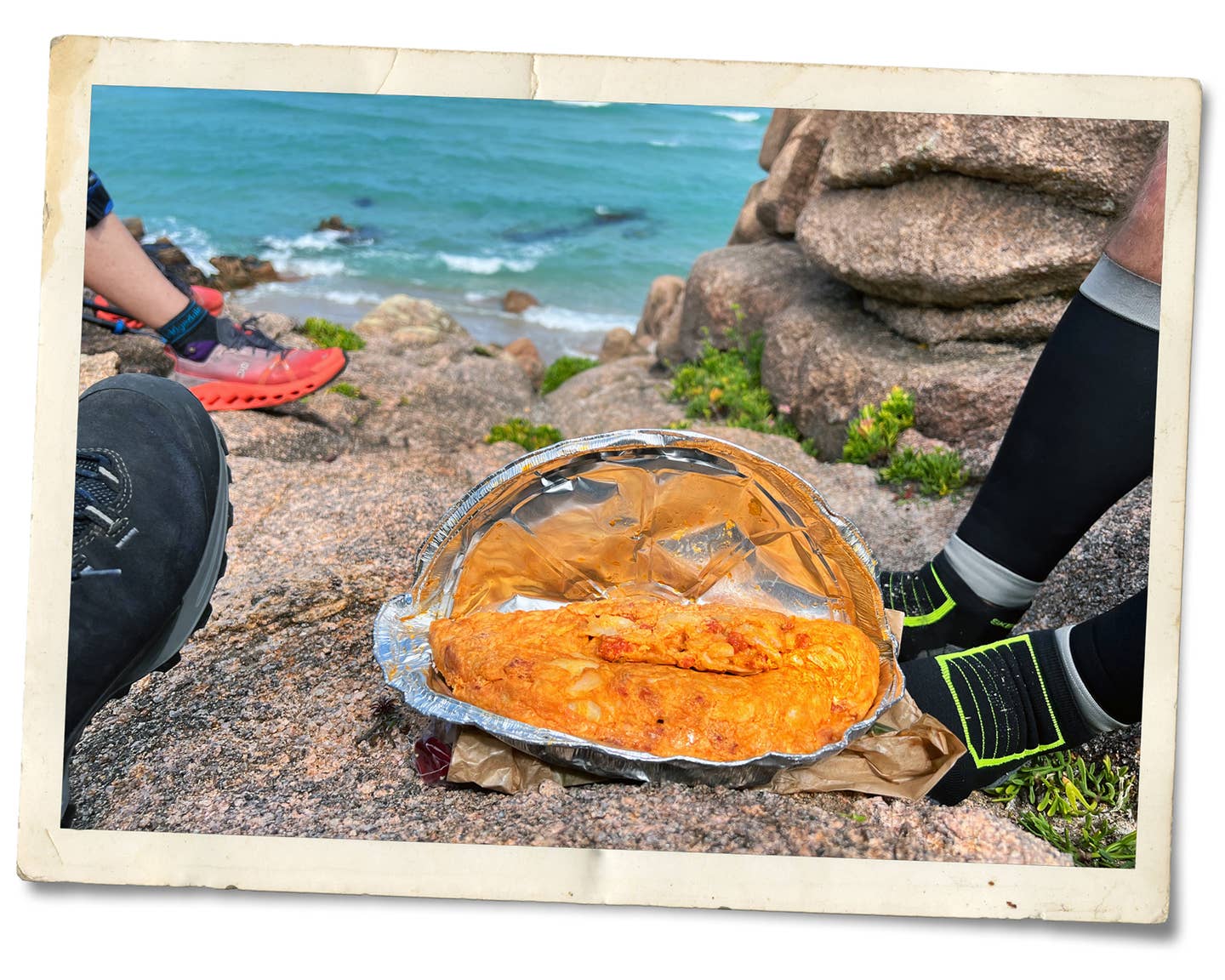
I ate it with my palms, relishing its silky, sticky texture between my fingers, and remembered the lesson of the percebes within the vertiginous kaleidoscope of sea, salt, sky, water, and wind. That conscious second gave me the vitality to pack up and proceed on.
Days 6, 7, and eight: To The Finish of the World
Miles of grueling ascents and terrifying switchbacks by way of gorse-lined paths left deep crimson scratches on our legs and arms. The spiny taxo perpetrator, a Galician image of energy and resilience, felt extra like mockery than motivation. We have been weary. The nearer we acquired to Finisterre, the extra trails converged onto “our” path. English grew extra frequent, the seafood extra acquainted, the tortillas firmer. The whole lot was simpler to eat with a fork. My untranslatable Galicia appeared to be slipping right into a barely extra generic Spain.
Though the trail is known as the Approach of the Lighthouses, the buildings themselves play a remarkably small function within the route’s panorama and structure. There have been days we didn’t see a single one, and others we noticed solely from a distance. It appeared becoming that our ultimate vacation spot, Faro de Fisterra—Europe’s most visited lighthouse, sitting practically 470 toes above sea degree from it’s highest level—gave the impression to be simply out of vary on our final day, irrespective of how far we walked or how excessive we climbed. Till it wasn’t. At 5:57 p.m. on that blue July day, we gratefully closed a chapter, inserting our palms on the rugged stone cross on the ocean’s edge, worn easy in sections by the palms of pilgrims and vacationers who got here earlier than us.
As if on cue, a busker started enjoying a gaita, an area bagpipe, one other reminder of the area’s Celtic roots. We drank Spanish-style gin-tónics (which we had renamed “glitter water” someplace round day three) and feasted on now-familiar tapas whereas the actual traskis—the goats roaming the peaks above us—appeared on with curiosity.
That night, I turned off my morning alarm, completely happy to let nature take its course. However as an alternative of sleeping by way of breakfast, I woke at daybreak to a room bathed within the glowing, salmon-hued gentle of a seaside dawn. It dawned on me that I had walked over 100 miles to shut one chapter, solely to see one other start. And thru the full-length home windows from my resort mattress, I watched the solar’s gradual, regular trek till it crested the distant hills on the very finish of the world.

